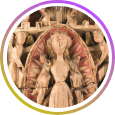Ushabti of King Taharqa. Egypt. Sudan. Royal Pyramid of Nuri I. Made of plutonic igneous rock (Syenite). Twenty-fifth Dynasty. 694-660 BC Measurements: 27 cm.
Discovered by George Reisner and the Harvard MFA expedition. 1917.
Provenance: Mustafa Abdalla Babeker, Khartoum circa 1930 and descendants. International market 2004. Private collection of Madrid.
Extraordinary example of one of the rarest ushabtis that can be offered in the international market. After the discovery and excavation of the pyramid in 1917, most of the 1,070 ushabtis that made up King Taharqa''s trousseau were divided between the Boston Museum, the Khartoum Museum, and several dozen specimens that went to different museums and private collections.
The ushabtis of King Taharqa have a varied typology both for the type of stone in which they were made and for their dimensions. The figure represented with the jat headdress, uraeus on the forehead and false beard. The crossed hands hold two sickles and two ropes with two sacks of seeds that fall from the back.
The lower front part has inscribed in hieroglyphic characters chapter VI of the Book of the Dead arranged in nine lines of text. This chapter referred to the magical formulas so that the ushabtis can carry out their tasks for the benefit of the deceased in the afterlife.
King Taharqa belonging to the Kushita Dynasty was the son of Piye who had conquered Egypt in 747 BC and the nephew of Shebitku, his predecessor on the throne. He stands out as a great soldier and ruler who had to face the expansionism of the Assyrian empire led by Sennacherib. Taharqa and the Egyptian-Kushite army collaborated in the defense of Jerusalem against the Assyrians.
The reign was one of prosperity. Taharqa restored ancient temples and carried out additions to the Great Temple at Karnak. At that time there is a revival of artistic traditions and proof of this is the use of hard stones in sculptures and funerary statuary as was the case in the Old and Middle Kingdom.
The function of the Ushabtis was to carry out all the manual tasks that the deceased needed for his daily life and sustenance in the afterlife as a replica of the tasks carried out by the servants of the deceased in real life.
Bibilography:
.-Sudan. Ancient Kingdoms of the Nile. 1997.
.-Chaouabtis des Travailleurs Pharaoniques pour lèternité. Catalog Exhibition., Paris, Louvre 2003.
.-Aubert: Statuettes egiptiennes chaouabtis, oushebthis. Paris 1974, pages 185-195.
.-AA.VV. Nubia: The kingdoms of Egypt and Sudan. La Caixa Foundation 2003. 27cm
This lot requires export license
 DECORATIVE ARTS
DECORATIVE ARTS
Starting price
40.000 €
NOT SOLD
duran-app.lot.title_phone_bid
Phone 1:
Phone 2:
Comments:Confirm your maximum bid
At the time of auction we will contact you by phone:
Confirm your maximum bid
Loading…
Conecting with the server
Are you sure you want to buy the lot?
Durán Sala de Arte 2024
Confirm your maximum bid